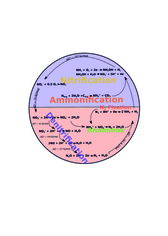Preprint
Article
Determination of N2 and N2O Fixation Rates in Leguminous Plants and Three Different Soil Types by Labeling Experiments with Stable Nitrogen Isotopes
Altmetrics
Downloads
490
Views
578
Comments
0
This version is not peer-reviewed
Submitted:
26 October 2018
Posted:
26 October 2018
You are already at the latest version
Alerts
Abstract
Nitrogen (N) is an essential nutrient and plays an important role in plant growth and physiology. In addition, N is also the limiting nutrient in most terrestrial ecosystems. The increasing use of N fertilizers increases agricultural production, but also has negative impacts on biodiversity, water quality and increases emissions of greenhouse gases such as nitrogen oxides (NOx) and nitrous oxide (N2O) into the atmosphere. N2O is a strong greenhouse gas and the product of microbial transformation processes of N introduced into soil and groundwater (nitrification and denitrification). The production of N2O in soils is highly dependent on oxygen and water content, soil temperature and texture and the available amount of reactive nitrogen (NO3- or NH4+). In agricultural soils, N2O emissions are also influenced by the type of fertilizer used, crops grown, soil pH and NO3- concentration. Refined forms of land management, such as the cultivation of legumes, can reduce the use of fertilizers and thus also the emission of N2O. Legumes can use symbiotic nodule bacteria (rhizobia) to bind atmospheric N2 and make it available to the plant. Non-symbiotic soil microorganisms such as cyanobacteria or other heterotrophic and autotrophic prokaryotes are also able to fix N2. Furthermore, the N2-fixing enzyme nitrogenase, which is specific for most organisms, is not specific for other N2 compounds, especially N2O. To study the N2 and N2O fixation potential of soils and legumes, experiments with isotope-enriched N-gases (100 mol% 15N2 and 15N2O) were performed. Three different soil types (forest, meadow and wetland) as well as legume plants inoculated with rhizobia bacteria (Rhizobium leucaneae) (Leucaena leucocephala) were incubated in microcosms with different mixing ratios of N2 and N2O over a period of one week. The measured 15N enrichment was then used to determine the biological uptake rates. Both in plants and in soils admixtures of up to 40% N2O had no influence on the N2 fixation rate. N2 uptake rates were 1.2 ± 0.4 ug N gdw-1 d- 1in forest and grassland soils and 3.9 ± 1.2 ug N gdw-1 d- 1 in wetland soils. In contrast, the N2 fixation rates of leguminous plants were significantly higher (130 ± 40 ug N gdw-1 d- 1), with the highest accumulation not in root nodules but in the roots. In both plants and soil, the N2O fixation of 0.2 ± 0.1 ug N gdw-1 d- 1 could only be measured from a concentration of 4 vol%. The results indicate that both soils and legumes have a high potential to bind atmospheric nitrogen in the form of both N2 but not N2O. The fate of nitrogen in soil needs to be further investigated. N2 fixation seems to play an important role in wetland soils. Legumes in particular have the potential for NH4+ input and N2O reduction, as most of the solid nitrogen has been transferred to the roots, which can contribute significantly to soil nutrient input.

Keywords:
Subject: Environmental and Earth Sciences - Environmental Science
Copyright: This open access article is published under a Creative Commons CC BY 4.0 license, which permit the free download, distribution, and reuse, provided that the author and preprint are cited in any reuse.
MDPI Initiatives
Important Links
© 2024 MDPI (Basel, Switzerland) unless otherwise stated




